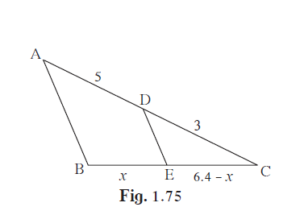In the given figure, A - D- C and B - E - C seg DE || side AB If AD = 5, DC = 3, BC = 6.4 then Find BE.
Problem Set 1 | Q 7 | Page 28
In the given figure, A – D- C and B – E – C seg DE || side AB If AD = 5, DC = 3, BC = 6.4 then Find BE..

In the given figure, A – D– C and B – E – C seg DE || side AB If AD = 5, DC = 3, BC = 6.4 then Find BE.
\[\therefore \frac{CD}{DA} = \frac{CE}{EB} \left( \text{ By basic proportionality theorem } \right)\]
\[ \Rightarrow \frac{3}{5} = \frac{6 . 4 - x}{x}\]
\[ \Rightarrow 3x = 32 - 5x\]
\[\Rightarrow 8x = 32\]
\[ \Rightarrow x = 4\]
Answer:-
Given: AD = 5 DC = 3 BC = 6.4 DE || AB
Step 1: Use the basic proportionality theorem From the given information, we know that DE || AB, which means that triangle ADC and triangle CEB are similar. Therefore, we can use the basic proportionality theorem to find the length of segment BE.
CD/DA = CE/EB Substituting the given values, we get:
3/5 = (6.4 – x)/x
Step 2: Simplify the equation Multiplying both sides by x, we get:
3x/5 = 6.4 – x
Adding x to both sides, we get:
3x/5 + x = 6.4
Multiplying both sides by 5, we get:
3x + 5x = 32
Simplifying, we get:
8x = 32
Dividing both sides by 8, we get:
x = 4
Step 3: Find the length of BE Substituting the value of x in the equation we got in step 1, we get:
3/5 = (6.4 – 4)/4 = 0.6
Therefore, CE/EB = 0.6, which implies that EB/CE = 1/0.6 = 5/3. We also know that CE = BC – BE = 6.4 – BE. Substituting this value, we get:
EB/CE = 5/3 EB/(6.4 – BE) = 5/3 3EB = 5(6.4 – BE) 3EB = 32 – 5BE 8EB = 32 EB = 4
Therefore, the length of BE is 4.
Problem Set 1 | Q 7 | Page 28
Click Here for All Textbook Soutions of Chapter 1: Similarity
